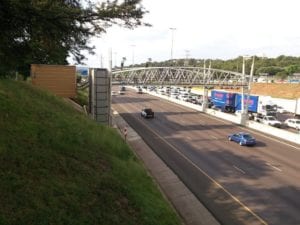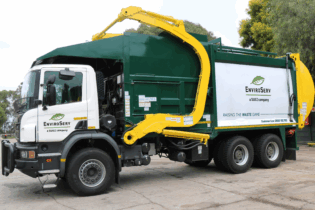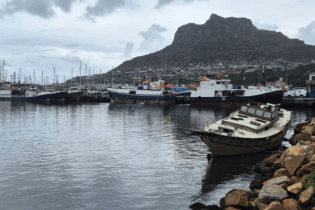Transport operators are experiencing an increase in the costs of moving goods through Gauteng as a result of the implementation of e-tolls. Simon Foulds speaks to industry experts to find out how the system is impacting operators.
Gavin Kelly, technical and operations manager at the Road Freight Association; Beric Croome, tax executive at ENSafrica; and Vusi Mona, general manager at SANRAL, discuss how the system is impacting the road transport industry in Gauteng and the VAT consequences for operators driving on the toll roads. Barney Curtis, chief executive officer, FESARTA (Federation of East and Southern African Road Transport Associations) highlights the problems foreign truck operstors are experiencing as they drive through Gauteng. VAT Kelly says the RFA raised the VAT concerns with SANRAL during the initial planning stages of the toll roads in Gauteng and were assured this would be taken care of. “Nazir Alli noted that freight operators could ‘claim the VAT back’. The question that arises is: will this be done in the quarterly VAT reconciliations or will it be done at the end of a financial year through the standard tax operating expenses claim?” Croome states the operator and fleet manager will be entitled to recover the VAT paid on the e-tolls as an input credit when submitting its VAT returns to SARS, so long as the travelling was for the purpose of making taxable supplies and they receive a valid tax invoice that complies with the provisions of Section 20 of the Value-Added Tax Act, Act No 89 of 1991 (VAT Act). Furthermore, Section 20(5) of the VAT Act does not require that the name, address and VAT registration number of the company be reflected on a tax invoice where the consideration for the supply does not exceed the amount of R5 000. Impact of toll roads Asked what has been the impact of the toll roads on its members, Kelly says: “The bottom line is being affected because the business must carry the expense. An increased expense equates to increased rates and this in turn means an increase in the price of consumer goods. The cost of goods has increased and this will only be felt from April onwards as the warehouse goods reach shelves. “As we noted in our submissions regarding e-tolls, rates will increase – and that was before the last four fuel increases have been taken into consideration. Prices have already started to climb and the consumer is in for a hefty shock come April. SANRAL and the Department of Transport were warned about this, but they ignored the warnings.” Mona adds: “When evaluating the impact of e-tolls, there are two components to be considered. First, the benefits as a result of savings in travel time due to improved infrastructure. The upgrade of the freeway network resulted in substantial travel time savings as was also confirmed by other studies, such the study conducted by the AA. The benefits also relate to savings in vehicle operating costs (less stop/start, travelling on a good surfaced road vs a poor road, impact on clutch/brakes, etc). The second component to be considered are the costs associated incurred by road users by paying directly for the benefits accrued. For the Gauteng Freeway Improvement Project (GFIP), the economic impact report conducted by the Graduate School of Business at the University of Cape Town calculated the benefit to cost ratio to be 8:1, demonstrating the benefits to road users.” Traffic flow Kelly says trucks carrying freight are moving easier on the toll roads due to the large number of light motor vehicles that have left the freeways, which are now clogging up the alternative routes. Regarding operators switching to night time operations, Kelly adds some members have moved to the better off-peak times, but that not all freight has done so. Mona is of the opinion that the improvement of the GFIP has definitely improved the flow of traffic due to expanded lanes and upgraded interchanges. E-tolling is just a payment method to ensure that users of the network pay for the benefits of the improved infrastructure and the ongoing maintenance thereof. The fees collected mainly go towards road maintenance and debt servicing. Kelly concludes: “One of the main frustrations from members lies in the billing processes, which are flawed. Cost is being felt in creating capacity to administer and control invoices from SANRAL which seem to be incorrect.” Foreign driversCurtis says, “One of the main concerns with transporters foreign to South Africa, is that the tolls have to be paid in South African Rands. At this time, there doesn’t seem to be a facility to pay in other currencies and FESARTA is having ongoing negotiations with the Department of Transport, to try and resolve this matter.”
“At present, foreign vehicles’ number plates are being read by the gantries, but their owners are not being invoiced. This means that vehicles foreign to South Africa are ostensibly using the upgraded freeways for no charge.” “However, transporters should be careful. It is suggested by SANRAL, that once a system has been established to charge foreign vehicles, then the outstanding charges will also be invoiced. These charges will go right back to the start of the system last year.” “My advice to transporters foreign to South Africa, who wish to use the Gauteng Freeway Improvement Project (GFIP), is to go to the SANRAL website and get all the information from it. • Google “Sanral e-toll gantries map”. • Choose the “E-TOLL_MAP_class_A1_e-tag_Rate-Sanral” website. • It will take you to the GFIP map. • See the green circles on the map. These are the service centres on the GFIP. • The website will also give you other useful information on the e-tolls. • Go to one of these centres shown, or to SANRAL’s office in Pretoria, and you will get the full information on how to register. • Note, that the toll system only accepts Rands. • It is advisable to get e-tags for each of your trucks, as this is much cheaper and easier to manage, than to receive invoices in the post. • You can just drive through e-tolls, without registering with SANRAL, and you will get away with it for a while. But, be sure, SANRAL is working on the system to capture foreign vehicles, and then to back-date all toll fees. • Make sure your front number plate is legible, so the gantry can link your e-tag to the vehicle.”







